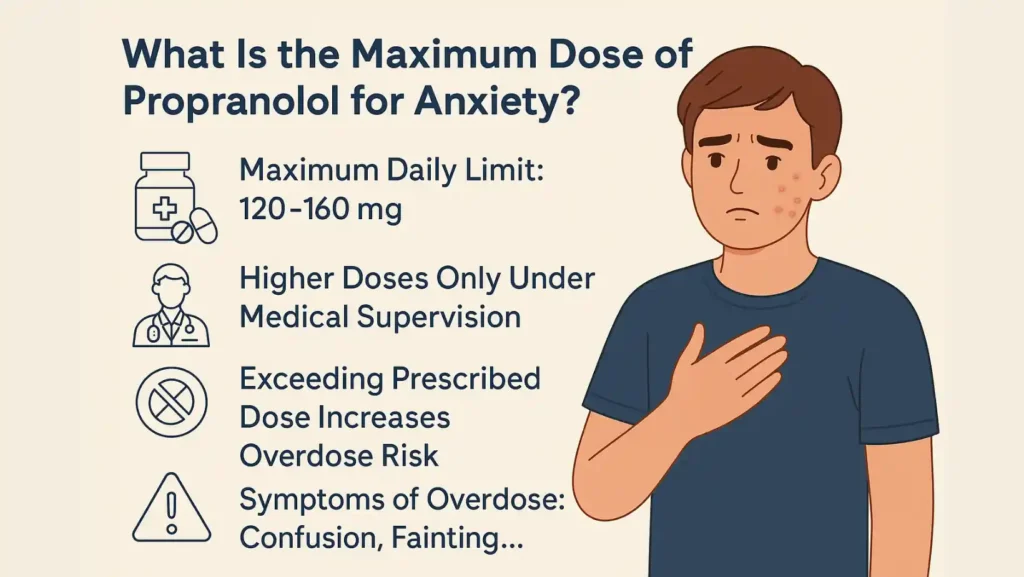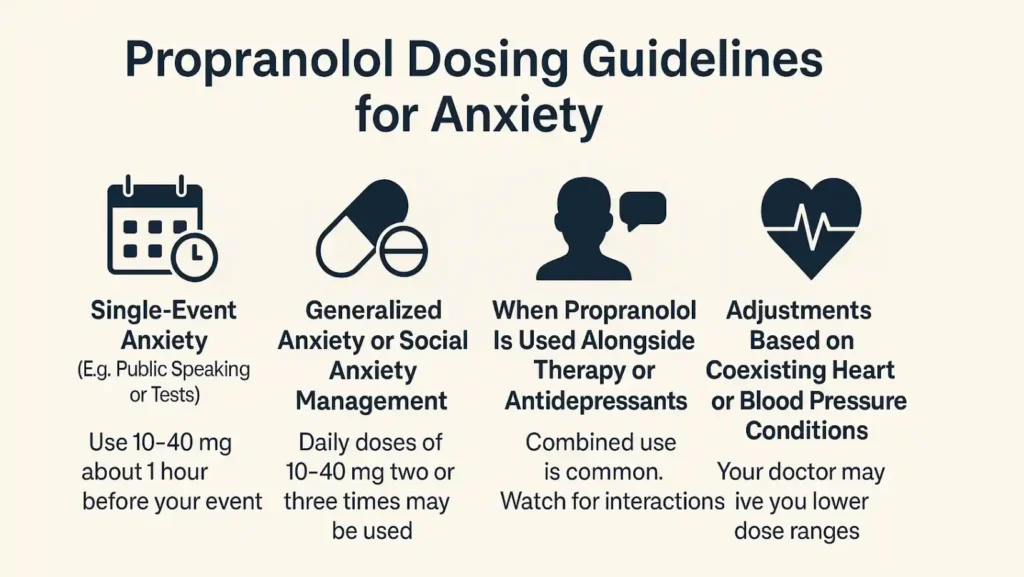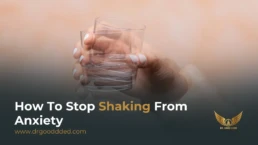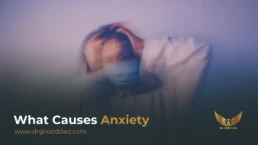Propranolol is used for trembling, a fast heartbeat, and sweating; it reduces the “fight or flight” response. But there is a safe upper limit. For most adults, about 120 mg per day is considered a reasonable ceiling for anxiety use under medical supervision. You should never exceed the dose your doctor prescribes. In rare cases, some doctors may allow up to 160 mg, but only with close monitoring.
Table of Contents
ToggleWhat Is Propranolol And How Does It Help With Anxiety?

Propranolol is a medicine in the class called beta blockers. It is mostly prescribed for heart conditions, high blood pressure, or migraines. But doctors often use propranolol for anxiety to quiet the physical reactions your body does when you’re scared or stressed.
How Propranolol Works: Controlling The Body’s “Fight Or Flight” Response
When you feel anxious, your body releases stress hormones (like adrenaline). That makes your heart beat fast, your hands shake, and you sweat. Propranolol blocks certain receptors that respond to those hormones. The result: your heart slows, trembling eases, and you feel steadier. It does not erase your thoughts or worries.
Why Doctors Prescribe Propranolol For Situational Or Performance Anxiety
If you know you’ll face a stressful event (public speaking, an exam, a performance) propranolol helps with the physical stress signs. It is useful when your mind is ready but your body is betraying you. Many physicians prefer it over sedatives because propranolol does not cause strong sedation or risk of addiction.
Short-Term Vs. Long-Term Propranolol Use For Anxiety
- Short-term use means using propranolol only before specific events.
- Long-term use means taking it daily to control ongoing physical symptoms.
- For long-term use, you need periodic monitoring of blood pressure, heart rate, and side effects.
Who Should And Shouldn’t Take Propranolol For Anxiety
You should tell your doctor if you have asthma, COPD (lung disease), slow heartbeat, low blood pressure, heart block, or diabetes. In those cases, propranolol might worsen problems or mask signs like low blood sugar. Also, in pregnancy or breastfeeding, doctors weigh risks and benefits.
Typical Propranolol Dosage For Anxiety
Usual Starting Dose: 10–20 mg Before Anxiety-Inducing Events
For a single event, doctors often start with 10 mg or 20 mg about 1 hour before the stressor. Sometimes, 30 or 40 mg may be used, depending on your reaction.
Maintenance Dose: 10–40 mg Up To Three Times Daily (If Prescribed)
If you use propranolol for ongoing anxiety, doses often run 10 to 40 mg two or three times per day. The total daily dose stays well below dangerous thresholds if prescribed safely.
Extended-Release (ER) Propranolol Dose Range
ER (long-acting) forms release the drug slowly, so you take it once daily. Typical ER doses are lower, often 80 mg daily, but your doctor might adjust it based on your needs and tolerance.
Factors That Affect Dosing — Age, Weight, Heart Rate, Medical History
Older age, low body weight, slower heart rate, liver or kidney problems all make doctors choose lower doses. Also, interactions with other drugs or existing heart conditions matter.
Always Follow Your Doctor’s Individualized Propranolol Dosing Guidelines
Your doctor may adjust your dose up or down over weeks. Never change it yourself. Stopping suddenly can cause dangerous rebound effects.
What Is The Maximum Dose Of Propranolol For Anxiety?
Maximum Daily Limit: Typically 120–160 mg For Most Adults
For propranolol for anxiety, most clinicians consider 120 mg/day as a conservative maximum. In some cases, 160 mg/day is used under strict medical supervision. This is the maximum dose of propranolol for anxiety that stays within safety margins for many people.
Higher Doses Only Under Strict Medical Supervision
In cardiac or other conditions, much higher doses (for example, 180–240 mg or more) are used. But for anxiety use, you do not need to go that high. Higher doses raise risk without proportionate benefits.
Why Exceeding The Prescribed Dose Increases Overdose Risk
Too much propranolol slows your heart too much, lowers your blood pressure too much, and can cause fainting, shock, or even cardiac arrest.
Symptoms Of Propranolol Overdose And What To Do Immediately
Overdose warning signs include confusion, very slow pulse, dizziness, fainting, trouble breathing, or seizures. If you suspect an overdose, call emergency services immediately.
Propranolol Dosing Guidelines For Anxiety

Single-Event Anxiety (E.g. Public Speaking Or Tests)
Use 10–40 mg about 1 hour before your event. Start low; try a small dose first when stakes are low.
Generalized Anxiety Or Social Anxiety Management
Daily doses of 10–40 mg two or three times may be used if physical symptoms persist. But many people benefit from combining this use with therapy.
When Propranolol Is Used Alongside Therapy Or Antidepressants
Propranolol addresses the body side of anxiety. Therapy handles thoughts and coping skills. Combined use is common. Watch for interactions with antidepressants, especially SSRIs.
Adjustments Based On Coexisting Heart Or Blood Pressure Conditions
If you have heart disease or low blood pressure, your doctor may give you lower dose ranges or monitor you more often.
Key Differences Between Propranolol Tablets And Extended-Release Capsules
Tablets act faster and wear off sooner, good for event use. ER capsules last longer, making them better for daily dosing.
Common Side Effects: Fatigue, Dizziness, Slow Heartbeat
You might feel tired, dizzy, or notice your pulse is lower than usual. These often improve over time.
Serious Reactions: Shortness Of Breath, Fainting, Or Low Blood Sugar
If you have asthma, propranolol can constrict airways and worsen breathing. Low blood sugar in diabetics may become masked by propranolol; fainting is also a serious sign.
Drug Interactions — Antidepressants, Asthma Medications, And Alcohol
Some antidepressants may increase propranolol levels. Asthma drugs often work opposite to beta blockers. Alcohol can worsen dizziness and low blood pressure. Follow propranolol dosing anxiety guidelines that include checks for interactions.
Monitoring Your Blood Pressure And Heart Rate While On Propranolol
Check your pulse and blood pressure daily or as directed. Record them to show your doctor. This helps detect early trouble.
Can You Overdose On Propranolol For Anxiety?
Early Signs Of Overdose — Confusion, Slow Pulse, Or Fainting
You may feel confused, dizzy, weak, extremely tired, or faint. Your pulse may be dangerously slow.
What To Do If You Suspect Propranolol Overdose
Call emergency services at once. Do not wait. Bring the medicine packet with you. Hospitals can give treatments to reverse the effects.
Safe Medication Habits To Prevent Accidental Overuse
- Use a pill organizer
- Take only what your doctor prescribes
- Never double-dose to “catch up”
- Keep medicines in the original container
- Share your full medication list with all your doctors
How Propranolol Compares With Benzodiazepines (E.g. Xanax)
Benzodiazepines calm anxiety more broadly, affecting the brain, and carry the risk of dependency. Propranolol mainly controls body signs, not mental worry. It is not habit-forming.
Beta Blockers Vs. SSRIs For Anxiety Control
SSRIs (antidepressants) treat long-term worry and mood. Beta blockers treat physical symptoms. Many plans use both with therapy.
When Propranolol May Be Added To An Existing Anxiety Treatment Plan
If you already take SSRIs or therapy, propranolol can be added for episodes when physical symptoms spike, like a performance event or panic with strong trembling.
Lifestyle Tips While Taking Propranolol
- Avoid heavy caffeine, nicotine, or alcohol; they counteract or worsen side effects
- Practice deep breathing, meditation, or progressive muscle relaxation
- Combine with therapy, especially cognitive behavioral therapy (CBT)
- If anxiety persists despite correct dosing, tell your doctor, you may need a change
- PracticeReport severe fatigue, dizziness, or changes in heart rate immediately
- Ask your doctor before adjusting the dose or schedule
These habits reduce the propranolol overdose risk, anxiety use, and help propranolol work better in your life.
FAQs
How quickly does propranolol work for anxiety?
Propranolol often starts to reduce physical anxiety signs within 30 to 60 minutes. Its peak effect is 1 to 2 hours after taking a dose, especially with immediate-release forms.
Can I take propranolol every day for anxiety?
Yes, in some cases, doctors prescribe it daily. But the maximum dose of propranolol for anxiety must be respected and should only be taken under a doctor’s prescription. Daily use needs close monitoring of your heart and blood pressure.
How long does propranolol last in the body?
Immediate-release forms last about 6 to 12 hours. Extended-release forms may last up to 24 hours. The effect duration depends on the formulation and your metabolism.
Is propranolol addictive or habit-forming?
No. Propranolol is not addictive. It does not produce cravings. However, do not stop it suddenly; stop under the doctor’s plan.
Can propranolol be taken with antidepressants?
Yes, sometimes. But interactions must be checked. Your doctor ensures that any antidepressants you take do not raise propranolol levels dangerously.
What should I do if I miss a dose?
If you miss a dose, take it when you remember unless it’s near your next dose. Do not double up. Contact your doctor for guidance.

This article is medically reviewed by Dr. Chandril Chugh, Board-Certified Neurologist, providing expert insights and reliable health information.
Dr. Chandril Chugh is a U.S.-trained neurologist with over a decade of experience. Known for his compassionate care, he specializes in treating neurological conditions such as migraines, epilepsy, and Parkinson’s disease. Dr. Chugh is highly regarded for his patient-centered approach and dedication to providing personalized care.








